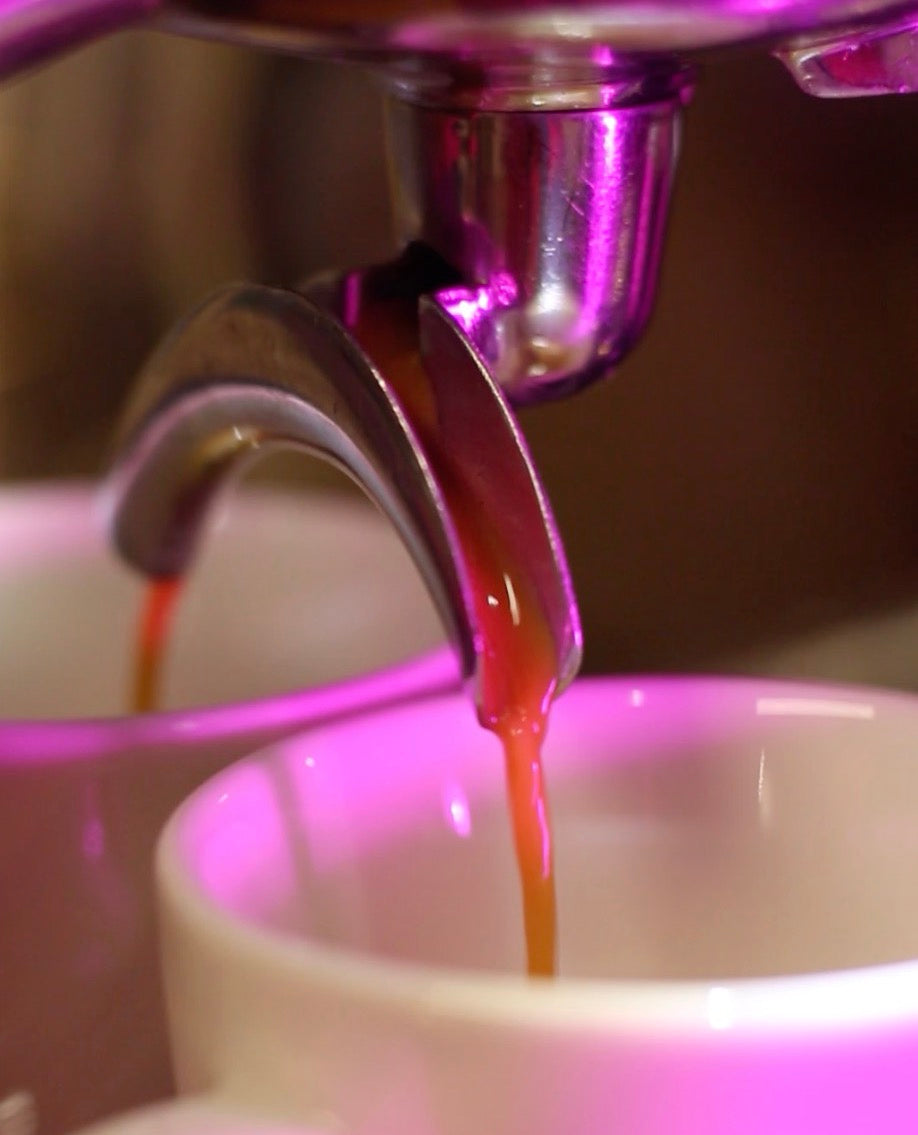NinetyPlus Panama Gesha Kemgin
Coffee Information
Kemgin is a coffee that belongs to the Ascent line of NinetyPlus, and the name refers to the post-harvest process that the coffee goes through.
It is a conjunction of Nekempte—a reference to a town in Ethiopia where varieties such as Gesha abound—and Ginger, a reference to ginger, whose aroma characterized the first iterations of this process.
Producer: NinetyPlus Estates, Joseph Brodsky.
Country: Panama.
Region: Piedra Candela, Chiriqui.
Altitude: 1200 - 1550 mts.
Variety: Gesha.
Post-harvest process: Dry fermentation, washing, and cherry drying.
Harvest: April 2021.


Photos provided by NinetyPlus.
Sensory Description
Orange blossom, jasmine infusion, ginseng, ginger, blackberry, prickly pear melon, honey, milk caramel.
Bright medium acidity, medium round sweetness and subtle low bitterness.
Medium body, a smooth silky texture and a delicate finish.
Import
This coffee was purchased directly from NinetyPlus Estates , without any intermediary. The kilo of green coffee cost USD $60 —27.7 times the C price at the time of purchase—, and the import cost was approximately USD $110, which brings the total cost to approximately USD $170. This does not include operating costs, design or packaging —developed in conjunction with Jorge Navajas— .
Additionally, with the purchase of this coffee, USD $5 was donated to plant a tree in the Volcán Barú National Park in Panama. NinetyPlus Estates directly contributes to coffee farming that is responsible with the ecosystem and maintains biodiversity, inspired by the forests and native varieties of Ethiopia.
Roasting
This coffee was the easiest to roast, compared to Juliette or Kambera. We immediately found marked descriptors and cleanliness in the cup; with a couple of tests we achieved a very sophisticated cup.
Toaster: Kaffelogic Nano 7
Load: 80 grams
Initial humidity: 10.4%, rehydrated to 16%
Total Time: 9 minutes, 34 seconds
DTR: 12.9%
Final Temperature: 218.1 ºC
Accumulated Temperature*: 15.6
Mass loss: 18.7%

*We calculate this value by dividing the area under the roasting curve by the load, ([ºC x min] / grams). We consider this value, in our roaster, to be a reasonable approximation of the development of the coffee, in a broad sense.
Water
Your coffee includes a mineral concentrate made in conjunction with Javier de la Vega, from Your Water , with our water recipe.
The idea of including this concentrate is so that your results can be as similar as possible to those we have when tasting and preparing coffee. Our water recipe seeks the greatest possible extraction, and a balance between acidity, sweetness and bitterness.
Dilute the mineral concentrate in a 5-liter container of distilled water, reverse osmosis water, or water with up to 7 ppm. You can also use something like Benedictine water or Nomad Water . Shake gently for 5 seconds and finally, wait 20 seconds before using.
Recipe:
— 185 ppm** Hardness ( MgSO₄ )
— 38 ppm** Alkalinity or Buffer ( NaHCO₃ )
**As an equivalent in CaCO3.
Preparation
In general, our coffees are designed for high extractions. We recommend fine grinds, higher temperatures, and longer ratios—for filtered, between 1:20 and 1:23; for espresso, between 1:3 and 1:5. In addition, we tend to prefer relatively low concentrations, where we find the greatest clarity in descriptors.
The idea of including recommended recipes is not to prevent you from experimenting with coffee, but to share the recipes with which we have had good results.
Hario V60 or Similar
Dose: 10 grams.
Water: 200 grams, recipe included.
Drink: 170 - 180 grams.
Time : 5 - 7 minutes.
Temperature: Boiling; 97ºC in Santiago.
TDS: 1.3 - 1.4%.
First discharge — saturation or bloom — 30 grams, swirl the coffee maker for 5 seconds making sure all the coffee is wet.
Second pour of 35 grams (65) at 30 seconds. Move the coffee maker gently in circles for 2 seconds.
Third pour of 35 grams (100) just before the water level reaches the coffee. Move the coffee maker gently in circles for 2 seconds.
Pour 35 grams (135) into the fourth cup just before the water level reaches the coffee. Move the coffee maker gently in circles for 2 seconds.
Fifth pour of 35 grams (170) just before the water level reaches the coffee. Move the coffee maker gently in circles for 2 seconds.
Final pour of 30 grams (200) just before the water level reaches the coffee. Move the coffee maker gently in circles for 2 seconds.
It is recommended to reach something close to these parameters with another coffee first. Try to make all pours from the highest possible height that does not create turbulence on the surface of the water, in a circular motion over the coffee and maintaining a controlled flow. In addition, it is recommended to keep the water boiling between pours.
AeroPress
Dose: 10 grams.
Water: 200 grams, recipe included.
Drink: 185 - 195 grams.
Time: 8 - 9 minutes.
Temperature: Boiling; 97ºC in Santiago
TDS: 1.3 - 1.4%
[Standard method.]
Pour the 200 grams of water over the coffee, trying to pour from as high as possible so as not to create turbulence on the surface of the water, and making sure to wet all the coffee evenly.
Insert the plunger without applying pressure to create a vacuum.
After 2 minutes, with the plunger still inserted, gently move the brewer in circles for 5 seconds.
After 4 minutes, with the plunger still inserted, gently move the brewer in circles for 5 seconds.
At 7-8 minutes, begin to press the plunger very gently, pushing past the sound of air.
It is recommended to first reach something close to these parameters with another coffee, and use the finest grind that makes it easy to press the plunger smoothly.
Espresso
Dose: 15 grams.
Water: The water you use in your espresso machine, or the included recipe, if you have a machine that allows it easily.
Drink: 45-50 grams.
Time: 15-20 seconds.
Pressure from pump: 6 bar
Temperature: 96-97ºC
TDS: 7 - 8%
It is recommended to previously reach something close to these parameters with another coffee. For something like a allongé , use the same parameters, but aim for a 75 - 90 gram drink.
Tricolate
Dose: 10 grams.
Water: 200 grams, recipe included.
Drink: 170 - 180 grams.
Time: 9 - 13 minutes.
Temperature: Boiling; 97ºC in Santiago
TDS: 1.3 - 1.5%
First pour —saturation or bloom— of 30 grams, move the coffee maker for 10 seconds ensuring that all the coffee is wet.
Second pour of 70 grams (100) at 60 seconds. Move the coffee maker gently in circles for 2 seconds.
Third pour of 100 grams (200) at 120 seconds. Move the coffee maker gently in circles for 2 seconds.
It is recommended to reach something close to these parameters with another coffee first. In addition, it is recommended to keep the water boiling between pours.
Music
All of our coffees also come with a Spotify playlist, featuring songs we like to listen to while brewing and drinking. Generally, the songs we include in each playlist relate to some sensory aspect of coffee; but explaining exactly how they relate goes beyond words.
Listen to Kemgin on Spotify

